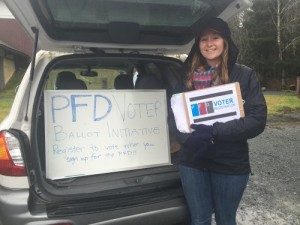
On November 8, Alaskans will vote on Ballot Measure No. 1, which would automatically register eligible individuals to vote when they apply for a PFD, unless they opt out. Through mid-October, the campaign in favor of the initiative had spent over $1 million, despite the lack of formal opposition. But would the initiative actually improve voter turnout?
In order to vote in Alaska, a person needs to register 30 days before the election. That means going to a place like the DMV or a tribal office to fill out a form, printing the application and mailing it in, or using the new online option. A bipartisan coalition of organizations and state leaders hope to add one more way: automatic voter registration. If ballot measure one passes, when you apply for your PFD, you will be automatically registered to vote unless you opt out.
Five states have recently enacted similar automatic voter registration laws.
Professor Barry Burden with the Elections Research Center at the University of Wisconsin said in most countries, all voters are automatically registered. Putting the onus on the voter to register is the exception, not the norm. The process was created in the United States about 120 years ago for a couple of reasons, he said.
“One of the incentives for voter registration was to prevent fraud and try to provide a secure system to insure each person got to vote once and only once,” Burden said. “But it was also an effort to try to keep immigrants from participating, undesirable populations, transient groups, sometimes Irish or Germans from participating, so it had a sort of discriminatory effect.”
Automatic voter registration can reduce some of those problems, he said.
Oregon is the only state where automatic registration is already happening, and because it was just implemented, it’s too soon to see how it impacts voter turnout. But Burden said other data suggest the practice will get more people to the polls.
“There are surveys, for example, in previous presidential elections that ask non-voters why they didn’t vote. In 2012, something between 5 and 6 percent of non-voters told us the reason was something related to voter registration. So it’s likely to have a modest but positive effect on voter turnout.”
The Division of Elections estimates that automatic registration could catch up to 70,000 people who are qualified to vote but not registered. The process, if implemented, would also update registration records.
Kim Reitmer, who is helping run the campaign in favor of the ballot initiative, said if it passes, organizations like Get Out the Native Vote can shift focus from voter registration to education.
“We’re hoping that by allowing people to have this automatic process, they can then put their resources and time into learning who they might want to vote for, the ballot initiatives, a little more of that education process, too,” Reitmer said.
But Suzanne Downing, who writes the political blog Must Read Alaska, said the initiative solves a problem that doesn’t exist because people can already register in many different ways.
“And it is a function of citizenship that you go and you actually fill out one form, very easy to do, and if you file for your PFD, you can certainly figure out how to register to vote,” Downing said.
Downing also claims the idea is an expensive proposition.
In 2015, the Lt. Governor’s office estimated that if the ballot initiative passed, it could cost about $930,000 to implement and $300,000 every year after that.
Proponents of the cause say those numbers are outdated because they don’t reflect Division of Elections computer upgrades that have already happened or how much time and money can be saved by sharing data.
The division said it wouldn’t know the exact impact on finances, computer system compatibility, or work flow unless the initiative passes and contracts are put out to bid.
Anne Hillman is the healthy communities editor at Alaska Public Media and a host of Hometown, Alaska. Reach her at ahillman@alaskapublic.org. Read more about Anne here.





